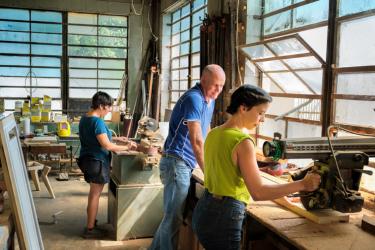When it comes to refurbishing furniture, Jim Slattery of The Gilder's Tip may very well be St. Louis' best-kept secret. He's a man who revels in the history of his craft and uses that knowledge to return family heirlooms to their original glory, or if you're short on antiques, can even recreate historical styles in amazing detail. He has hundreds of pieces in his body of work ranging from styles made popular in the late 1700s all the way up through the mid-1900s, utilizing a combination of research, period-appropriate techniques and patience.
Slattery grew up around craftsman. In fact, it's in his blood. Slattery goes on, “I have a craftsmen background on my mom's side that goes back generations. I mean if I picked up a hammer in their presence I had to know how to hold it right. Turned out that I had a knack for it.” He continues, “My grandfather and great uncle had a woodworking shop. My great uncle taught me gold leafing when I was only 13 or 14 years old, and I would work with them.”
From there, as Jim puts it, it was just a matter of being in the right place and learning from masters of their crafts. “I've been blessed to always fall into groups with great guys.” It's that path that gave Slattery the tools he needed to open his own company, The Gilder's Tip, in 1988 in the very location where he still works today. “I was 27, and I decided that I had to start doing it for me. I started out doing mostly gold leafing for some churches. That's why I called my company The Gilder's Tip. It's a tool in gold leafing. I caught the attention of a couple of amazing craftsmen. The next thing I knew, they were sending clients to me and it's snowballed ever since.” Today he furnishes the homes of some of the most influential names in the city and all over the country.
For Slattery, nearly every project is different and involves a fair amount of research. Mostly what it comes down to is the patience to focus on making each piece its best and to keep learning from his peers and history. “Especially when refurbishing, you have to know every detail: the chemistry of the old finishes of the time, the techniques used, what's age and what's abuse. Seeing what's there and applying that experience is very important.”
Looking forward, Slattery has no interest in retirement. If it were up to him, he would surely go the route of Michelangelo and continue his work for as long as possible. He continues, “I could probably sell the shop and retire but I don't want to do that. First of all, I'd be letting my clients and my employees down. These people have become friends. There's a trust there. That's what you work toward your whole life. That's what makes it fun, and I think I enjoy this more than I would enjoy retirement.”
To follow Slattery's work or to find out how you can upgrade your own antique furniture, visit www.thegilderstip.com.











